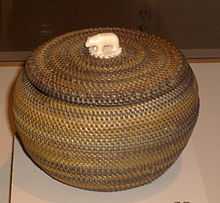Baleen basketry


Baleen basketry is a particular type basketry of Alaska Native art made from whale baleen developed Barrow, Point Hope, and Wainwright, Alaska by North Alaskan Iñupiaq people. At the dawn of the 20th century, this baskets are copy a willow-root basket in baleen (a flexible material found in the mouths of Mysticeti or baleen whales). Thin strips of baleen are cut and attached to ivory disks at the start. A coiling method is used to sew baleen bands together, ending with a carved ivory knob on the handle.[1] Most baleen baskets are made by men for sale to tourists, and so is one of the youngest basketry traditions in North America.[2] Over time, distinctive styles have developed, and since the 1970s, more women have become involved in what was originally a predominantly male occupation.[3] Often used the expertly carved finials Siberian Yupik of the St. Lawrence Island and Iñupiaq of the King Island carvers.[4]
The first baleen (suqqaq, qupitalik, savigaaq in Iñupiaq) basket (aguummak, aguummaq in Iñupiaq) was made at Barrow after the termination of commercial whaling. The exact date is still in doubt, but the preponderance of available evidence suggests the event took after sometime between 1914 and 1918, after whaling ended and before the intensification of the North American fur trade.[1]
Kinguktuk (1871–1941, also spelled Kiŋaqtaq in Iñupiaq; and his wife: Qusraaq) is recognized as the first baleen basketmaker with his first pieces made between 1914 and 1918 in Barrow. He was perhaps the only baleen basketmaker as late as 1931.[1] Today, most of baleen basketmakers lives in Point Hope, Alaska.[5] Kinguktuk's early baskets were woven in the single-rod coiling of their willow-root prototypes, and already had starter pieces, the perforated ivory discs used to attach beginning stitches, at the center of their lids and bases.[1]
References
- ↑ 1.0 1.1 1.2 1.3 Molly Lee (1998), Baleen Basketry of the North Alaskan Eskimo. University of Washington Press, Seattle
- ↑ http://www.burkemuseum.org/static/baskets/idgame/bnae.html
- ↑ http://natural-history.uoregon.edu/collections/web-galleries/inupiaq-baleen-baskets
- ↑ http://oomakpak.wordpress.com/2010/11/22/northwest-alaska-inupiaq-baleen-basketry/
- ↑ http://basketmakers.com/topics/bymaterial/baleen/baleenbasketmakers.htm